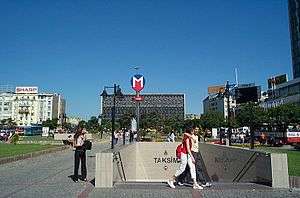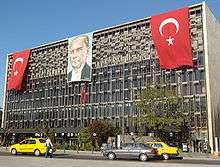Atatürk Cultural Center



Atatürk Cultural Center (1969-1977) (Turkish: Atatürk Kültür Merkezi) is in Istanbul, also simply called AKM. As the focal point of Taksim Square, it is not only a multi-purpose cultural center and opera house, but an icon of Istanbul. The AKM is considered an important example of Turkish architecture from the 1960s.[1]
Two Turkish architects, Feridun Kip and Rüknettin Güney, proposed the building of the center on May 29, 1946, and work began on the building's foundation until funding was halted in 1953. In 1956, construction resumed with Hayati Tabanlıoğlu as the architect. The building, originally called the Istanbul Culture Palace, was finished after 13 years and was dedicated on April 12, 1969 [2], twenty-three years after the 1946 proposal. However, a fire broke out 19 months later on November 27, 1970, during a performance of Arthur Miller's play The Crucible (the Turkish language version being Cadı Kazanı, "The Witch's Cauldron"). There was no loss of life in the fire but with the building IV. A part of the goods brought from the Topkapı Palace also burned ( a caftan belonging to Murad IV , a valuable Qur'an, a picture showing Murat IV) for the play of Murad . The source of the fire could not be detected.
The center has been closed since 2008, when a major refurbishment to bring the building up to date before Istanbul took over the title of European Capital of Culture in 2010. The AKM is a model of environmentally friendly preservation. The main visible addition are the louvers onto the aluminum façade as part of the energy-saving design strategy. The modernization works were designed by renowned Turkish architecture firm Tabanlıoğlu Mimarlık.[3]
In 2013 it was reported that the AKM is to be demolished as part of the proposed redevelopment plans for the Gezi Park and Taksim Square area and replace it with another opera house and a mosque.[4]
The complex
The complex comprises the "Grand Stage", a hall with a 1,307 seat capacity hosting theater acts of Turkish State Theatres and performances of the Turkish State Opera and Ballet, and the "Concert Hall", a second hall with a capacity of 502 seats for concerts, meetings and conferences as well as an exhibition hall of 1,200 m² at the entrance. There are also the "Chamber Theatre" with 296 seats, "Aziz Nesin Stage" with 190 seats and a cinema hall with 206 seats.
Until 2008, the center has been the home to the
- Istanbul State Symphony Orchestra and Choir (İstanbul Devlet Senfoni Orkestrası ve Korosu),
- Istanbul State Modern Folk Music Ensemble (İstanbul Devlet Modern Halk Müziği Topluluğu) and
- Istanbul State Classical Turkish Music Choir (İstanbul Devlet Klasik Türk Müziği Korosu).
During the summer and Information months, AKM has hosted the Istanbul Arts and Culture Festival.
See also
References
- ↑ "1960's (Turkish Architecture in the Republican Period)". ArchMuseum.org. Archived from the original on September 13, 2011. Retrieved January 30, 2012.
- ↑ [https://theculturetrip.com/europe/turkey/articles/turkeys-striking-works-modern-architecture/ "Turkey's Most Striking Works of Modern Architecture", by Feride Yalav-Heckeroth, CultureTrip.com
- ↑ Arkitera website in English
- ↑ Plans for Gezi Park. BBC News. Retrieved 4 June 2013
External links
| Wikimedia Commons has media related to Atatürk Cultural Center, Istanbul. |
Coordinates: 41°02′12″N 28°59′16″E / 41.03667°N 28.98778°E